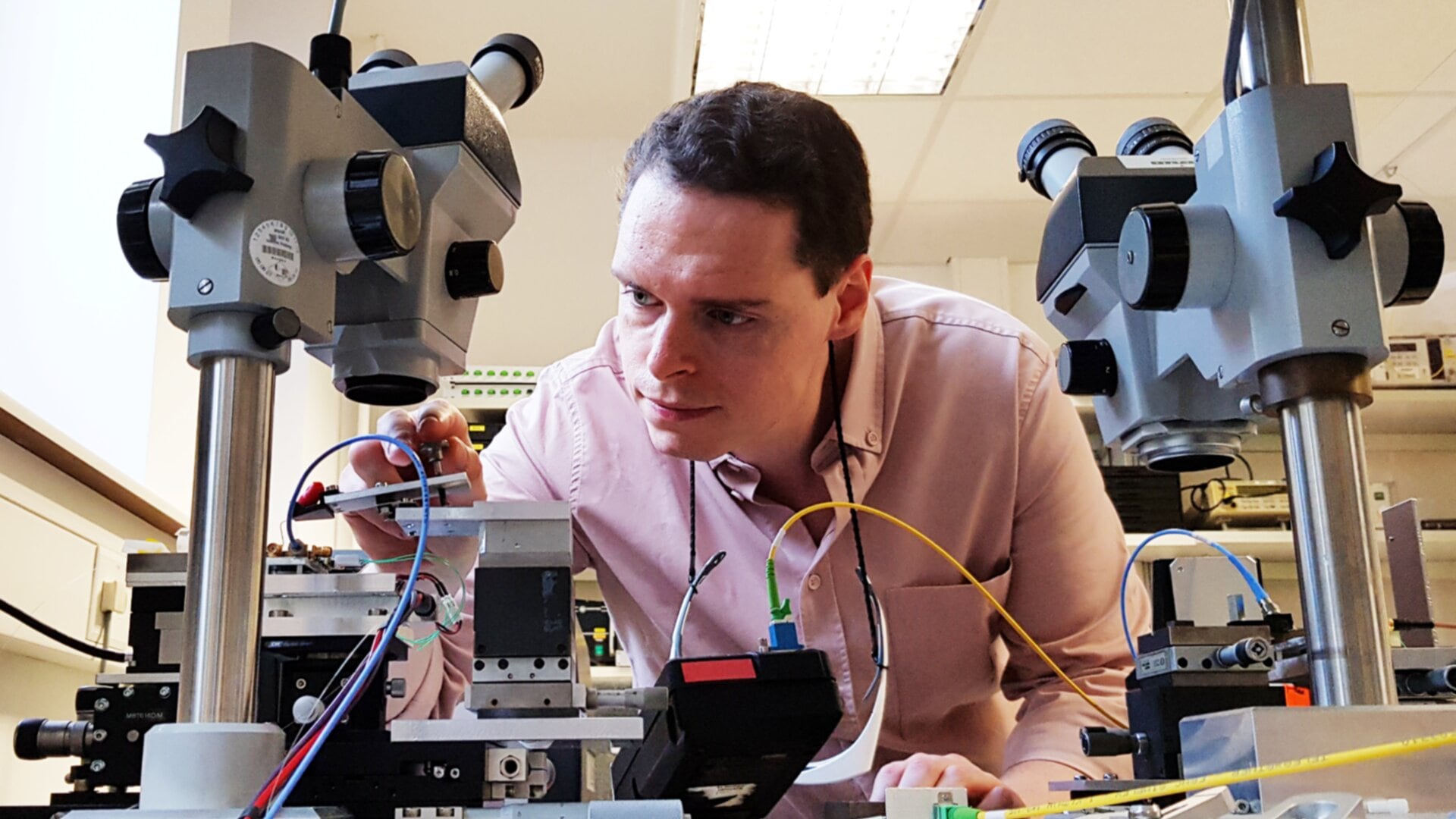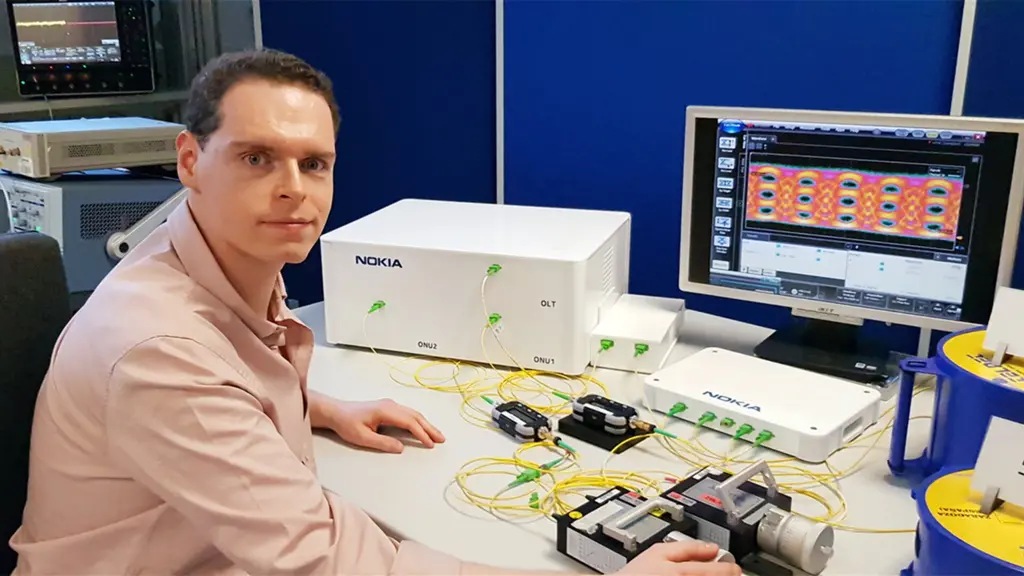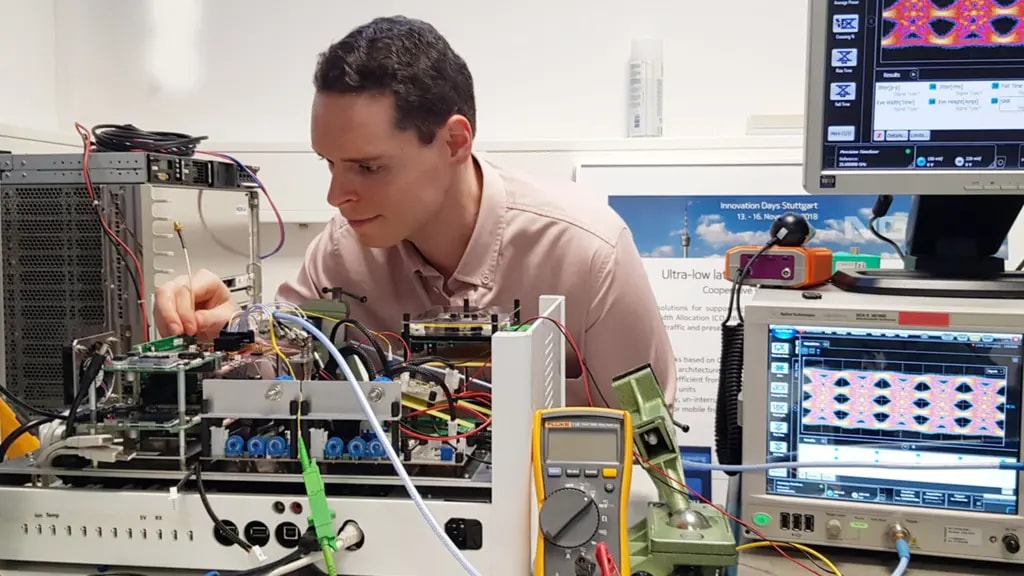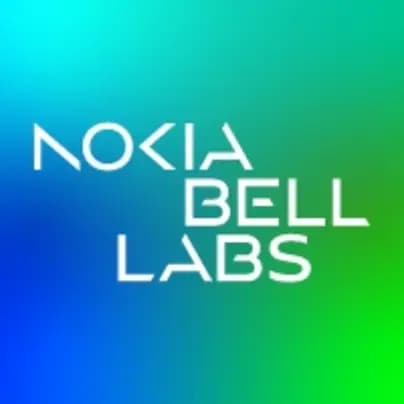This researcher is pushing passive optical networks to multiple limits

Earlier this year, Vodafone and Nokia broke the speed record for a passive optical network, or PON, delivering 100 Gbps speeds on a single wavelength. This is ten times the speed of the most advanced PON networks today – a big leap with the potential to have an outsized impact on the global broadband market. Fiber-optic systems are rapidly making their way to more homes and businesses, and this new advance in PON will inject these networks with unparalleled capacity. One of the principal researchers behind the record-breaking achievement is one of Nokia Bell Labs’ own, Robert Borkowski. A young researcher working at Bell Labs in Stuttgart, Germany, Borkowski seems to have a knack for coaxing the best performance out of passive optical systems while keeping costs down.
When asked about the breakthrough 100G PON trial with Vodafone and why it was so important, Borkowski explained that PON has lower speeds than deeper segments of optical network infrastructure, but it also must be much less expensive: “This makes it ideal for last-mile access to enterprise customers, or to provide the internet to homes, in an apartment building or a neighborhood.”
As new applications such as extended reality, cloud gaming and ultra-high-resolution streaming push the limits of last-mile access, faster PON has a big role to play. It is critical, he cautions, that PON “remains inexpensive so consumers and enterprise users continue to have affordable access to the network.” This means finding ways to unlock more bandwidth while trying to avoid the more expensive techniques employed in metro and core transport networks – at least until further advances make those techniques cheaper.
This is just the kind of problem that has always engaged Borkowski. Ever since he saw his first fiber optics lab at the Technical University in Denmark, he has itched to get his hands on the equipment and get it to do his bidding.
A love affair with fiber optics
Growing up in Poland, Borkowski’s mother fed him a steady stream of books on science experiments and math puzzles, in which he would immerse himself for hours every day. This led him to study telecommunications and computer science at Lodz University of Technology in Poland, but it was when he did his third-year foreign exchange in Denmark that his passion for optical innovation began. “I saw for the first time a real fiber-optics research lab, and I really wanted to pursue this direction,” he said. As he tells the story, his visit to that fiber optics lab was pretty much love at first sight.

It was powerful enough for him to stay at the university to pursue a Master’s and, then, a PhD in that same lab. Copenhagen, of course, also had its charms, offering a relaxed atmosphere, his daily bicycle commute to school and the company of the other likeminded students. But the lab was the center of his existence.
He first joined a fellow doctorate student working on building an orthogonal frequency-division multiplexing receiver, which encoded data on multiple carrier frequencies. He wrote the computer code to demodulate the signal and tested it for the first time after two months. He was hooked. “This was the first time I could really do an experiment in the lab,” he said. “It was really a great moment because I could put my hands on the hardware.” This was a kind of rite of passage for a budding young researcher.
This mixture of software coding and fiber optics was a theme that has followed him throughout his research career. For his doctorate, he worked as part of a larger team on a European-level project on cognitive optical networks — a self-aware version of software-defined networks. They were looking for ways to automate fiber-optic-network optimization and reconfiguration, reducing the time for such tasks from weeks to minutes. The project turned out to be ahead of its time, but the team learned valuable lessons.
The project work engaged the empiricist in Borkowski. His work focused on digital signal processing, which is the key to more efficient use of the optical signal, separating the important information in the signal from the noise. As with his earlier work, this was a software-coding problem using elements of machine learning, and it also involved hands-on work with optical transmitters and receivers to see how they behaved.
During this time, researching his doctorate and working on the cognitive network project, Borkowski attended conferences in his field, and it was at one of them that a colleague mentioned to him that a position had come up at Bell Labs in Stuttgart. He applied and met the team. “We had a really good discussion, and the group of colleagues were very knowledgeable; it felt really good,” he said “When they offered me the position, I immediately accepted. Bell Labs is not the sort of institution you would say no to.”
His work at Bell Labs shifted his focus away from the future-looking project of his doctorate and gave him the opportunity to bring his knowledge of digital signal processing to bear on practical problems in PON.
Looking for unused capacity in PON
The long-standing problem that Borkowski and the team are trying to solve is that PON systems are configured for the weakest link. For instance, while most homes or businesses served by a PON network in an urban area are relatively close to the central office, some small subset might have to traverse a longer fiber span and thus suffer a higher loss. As well, some customers might be on very old lossy fiber, while others are on newer fiber. In other words, there is a fair degree of variability. Today’s PON systems are configured to run at the speed that all links can handle, which is that of the oldest and longest links with the slowest speeds. This means that there is a great deal of capacity that is simply not being used on newer and shorter links.
What if PON systems could be set up to recognize this variability? Transmitters and receivers could then be reconfigured to take advantage of unused capacity to attain higher speeds on the links that can support them. This isn’t a far-fetched idea; some other telecom systems work this way. Cable access systems, for instance, deliver different speeds to subscribers depending on the condition of the link. But it had never been done for PON.

The answers to the variability problem fell in Borkowski's areas of expertise: signal processing methods that maximize speed on a given link, and hardware components responsible for emitting and detecting light intensity. This was the kind of problem that meant using his coding skills and careful, patient research in the lab working with transmitters and receivers to see what works in the real world.
Borkowski and his team developed signal processing algorithms that maximize bitrate for each optical link, which makes achieving 50G in real-world network deployments a straightforward process. They further demonstrated 100G speeds in the Vodafone-Nokia collaboration. That trial proved that it is now possible to make transmission speeds flexible by grouping users with similar physical characteristics together, thus optimizing speeds as appropriate for each group.
An additional benefit of the algorithms is lower latency on these optimized links, an emerging requirement for 5G applications. Beyond enterprise and residential access, there is an opportunity for higher-speed PON to handle applications such as fronthaul for 5G radios and even industrial automation, which requires low-latency, very high-bandwidth processing in the local edge cloud.
According to Borkowski, these throughput and latency gains are made possible by advances in optical devices and these new methods his team developed, which are the two main reasons he could keep the costs down. However, PON capacity cannot scale indefinitely under current approaches. Even with the latest advanced techniques being applied in 100G, researchers are coming close to what is known as the Shannon limit. The noise added by a transmitter and a receiver will not allow link speed to increase much further. On top of that, faster signals are more sensitive to distortion caused by the fiber itself, through an impairment called chromatic dispersion. At some point, no amount of processing power will be able to tease additional information out of these already highly optimized channels.
The continued goal of the team’s research, nonetheless, is to expand the capacity of inexpensive PON bringing broadband access to all. That means looking beyond today’s optical state of the art. Borkowski is already thinking about the limits that remain and researching ways to overcome those limits. He is looking at coherent reception technologies, which, although currently expensive, could be simplified by using fewer photoreceivers, simpler laser designs and less complex digital signal processor designs. Borkowski is also looking at technologies that would give PON networks the intelligence to optimize their operation, predict operating patterns and organize data in the fiber more efficiently.
With his commitment to making bandwidth affordable for more people, Borkowski has set off down many paths, any of which could make PON more accessible to all the world’s people. Those different paths of inquiry will keep Borkowski in the lab for years to come — which, of course, makes him very happy.
Written by Richard Hamilton
